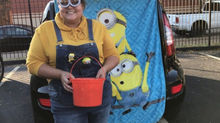Viewing the Total Solar Eclipse
- Cliff Sodergren, BPW resident since 2008
- Aug 15, 2017
- 3 min read

Next Monday, August 21st, we have the opportunity to see something that hasn’t happened in the St. Louis area for over 500 years: a total solar eclipse. (I would say this is a once-in-a-lifetime opportunity, except that amazingly we expect another total solar eclipse close to the St. Louis region in 2024.) So, what do you need to know about when this is happening, where to view it, how to view it, and what to expect?
The eclipse will take place on Monday the 21st beginning around 11:49 am, when the moon first begins to pass in front of the sun. This partial phase will last for some time before the moon fully blocks the sun, which will begin around 1:18 pm. This total phase, or totality, is the really amazing part and will last anywhere from a few seconds up to nearly three minutes, depending on your location. The moon will finally complete its journey in front of the sun at approximately 2:45 pm, signaling the end of the eclipse.
Where should you go to watch it? That depends a lot on how much flexibility you have. The biggest factor is to be somewhere that will be in the path of totality, preferably for as long as possible. The entire Benton Park West neighborhood is in the path of totality, but only for about 15-30 sec, depending on location. The farther south and west you can travel, the longer the duration of totality. For example, Carondelet Park will experience about 71 seconds of totality. Jefferson Barracks will have about 95 seconds worth. Head down to Festus for a full 2 minutes and 36 seconds!
Here is a helpful map that gives start and end times of the eclipse and duration of totality. Just click on a location and the info will pop up.
How can you watch a solar eclipse safely? This is an important question because looking directly at the sun can cause serious eye damage, and it is tempting to do so during an eclipse. The best option is to get a pair of eclipse glasses, which allow you to look directly at the sun. Many places are selling them for about $1. (Be sure they are rated for direct observation of the sun.) You will need to wear these anytime you are looking directly at the sun. The only time it is safe to look at the sun without them is during the total eclipse phase, when enough of the sun is blocked to make it safe for our eyes. Because this phase doesn’t last long, be careful about continuing to look at the sun after totality has ended. Keep those glasses handy!
If you don’t get eclipse glasses, you can still view the eclipse the “old-fashioned” way, by making a pinhole camera. All you need is a couple of sheets of paper. Even a kitchen strainer may work in a pinch.
What should we expect to see during a total solar eclipse? Visually, there are many effects to watch for: the sun’s corona (atmosphere), Bailey’s beads, the diamond ring effect, shadow bands, sunset on the horizon, visible stars, and eclipse shadows replicated on the ground hundreds of times as the light shines between tree leaves. There should be a noticeable drop in temperature, and many animals may behave strangely, including nocturnal animals, such as bats, becoming active.
To learn more about these effects, or other eclipse information, here are several helpful links:
A local organization promoting the eclipse. Lots of useful information. http://www.stlouiseclipse2017.org/
A blog explaining many of the interesting visual effects, including pictures and links to videos. http://astromaven.blogspot.com/2017/06/weird-things-happen-with-total-solar_72.html?m=1
A 16min video from one of my favorite youtube channels, explaining how to watch the eclipse and what to watch for. https://www.youtube.com/watch?v=qc7MfcKF1-s
A phone app that will give you exact times of the beginning and end of the partial and total eclipse based on your current location. https://itunes.apple.com/us/app/solar-eclipse-timer/id1203105865?mt=8
Happy eclipse watching!
Cliff Sodergren
Physics teacher at Crossroads College Preparatory School and BPW resident since 2008
“By wisdom the Lord laid the earth’s foundations, by understanding he set the heavens in place” -Proverbs 3:19

























Comments